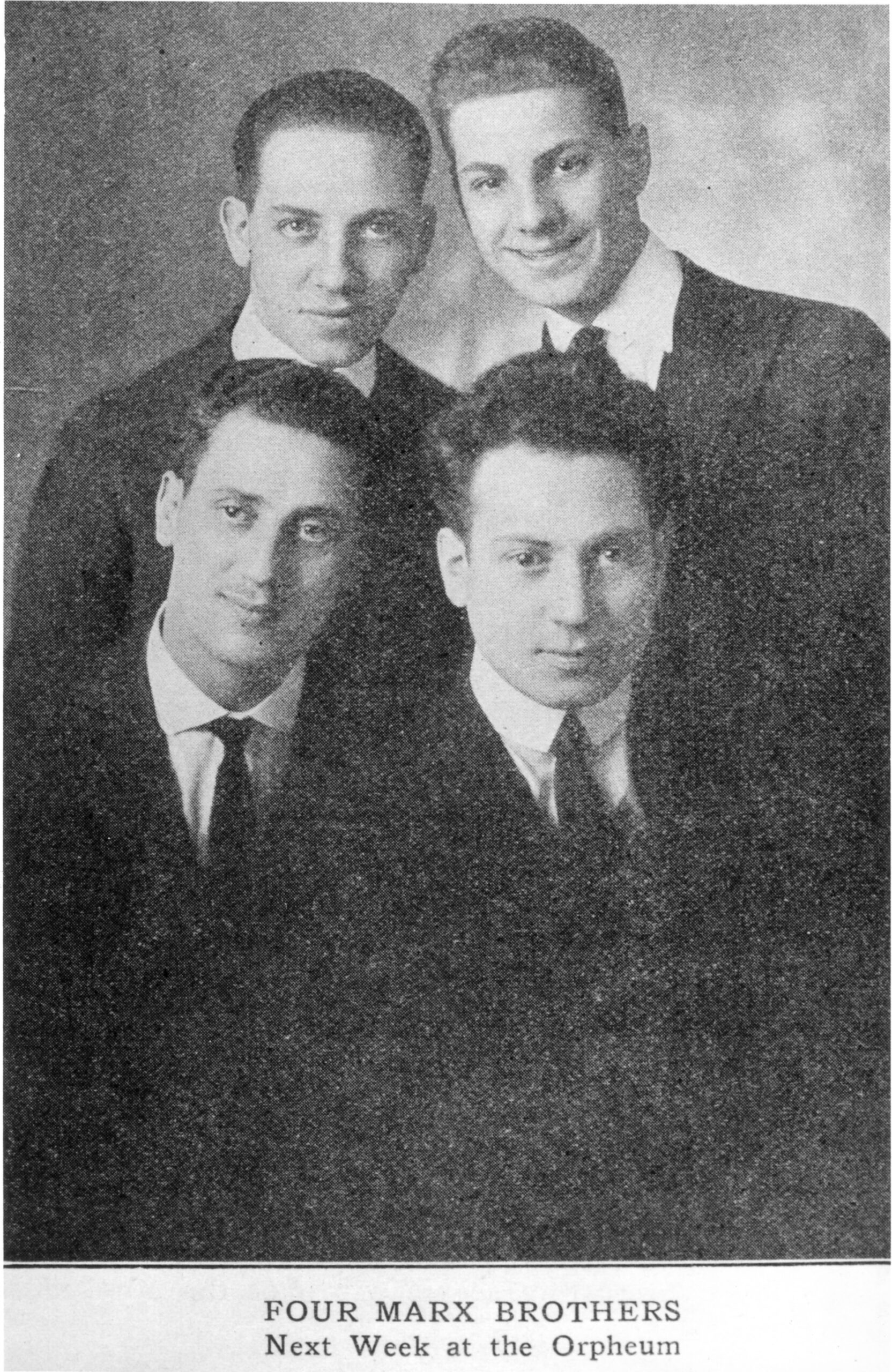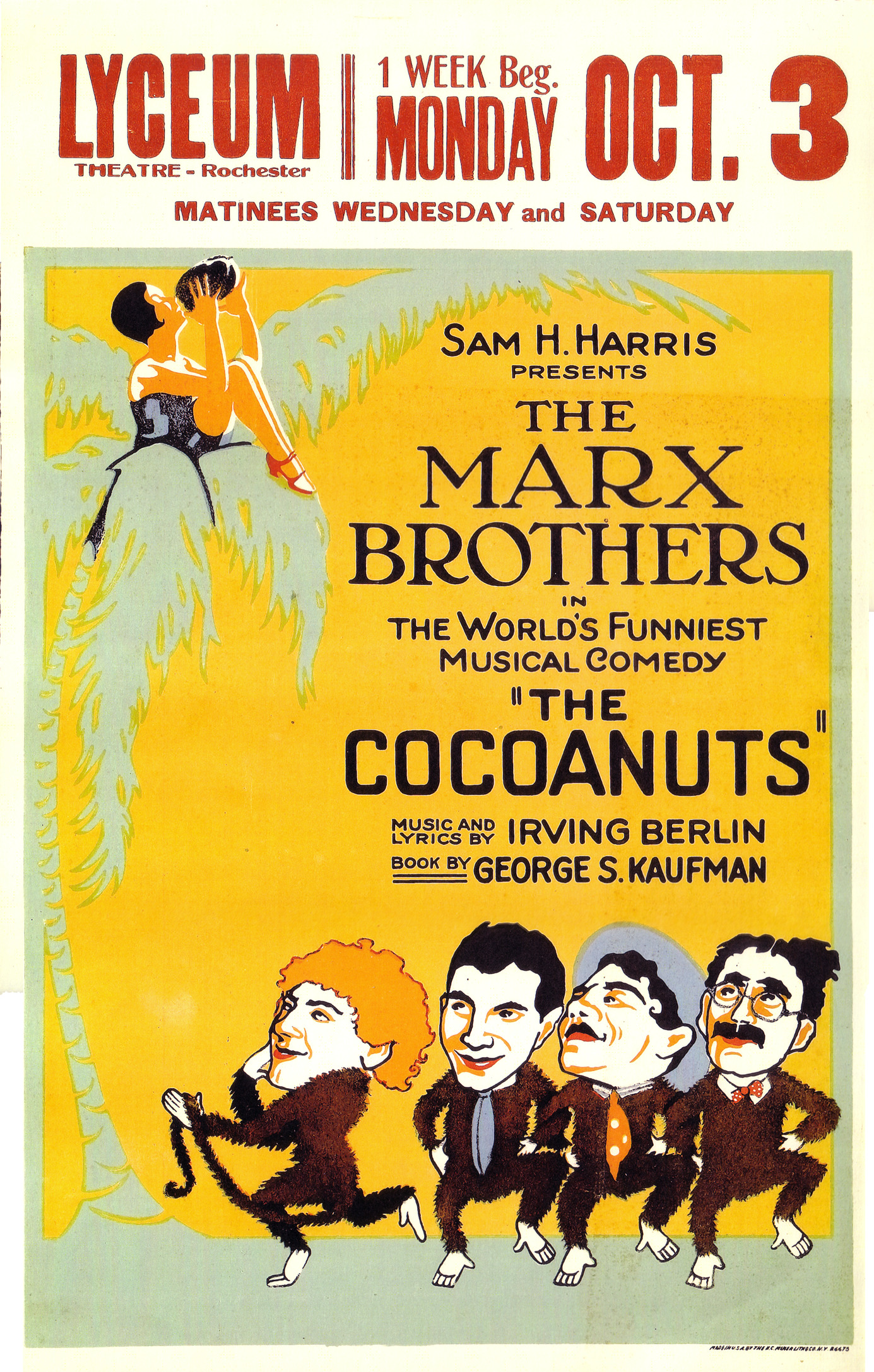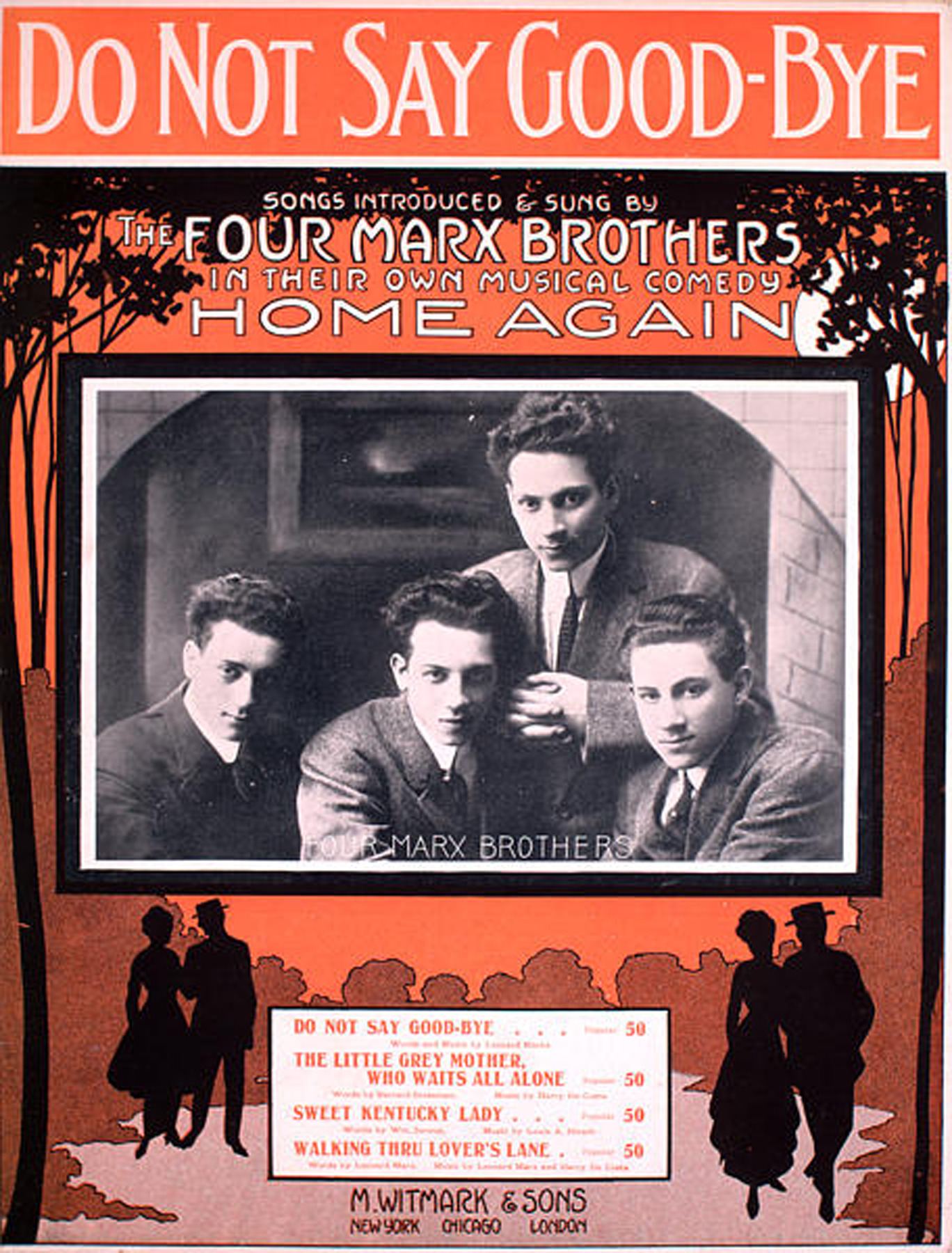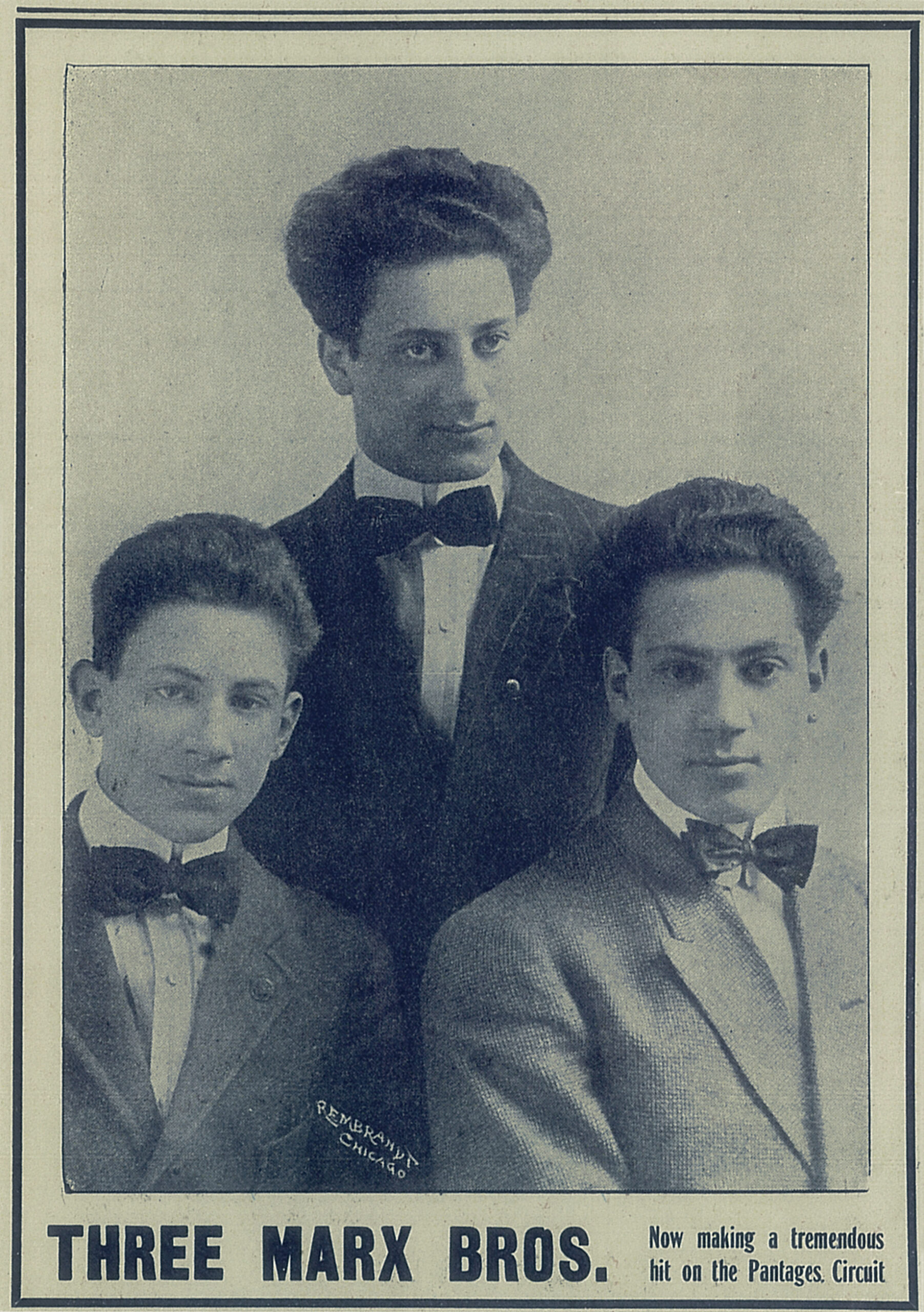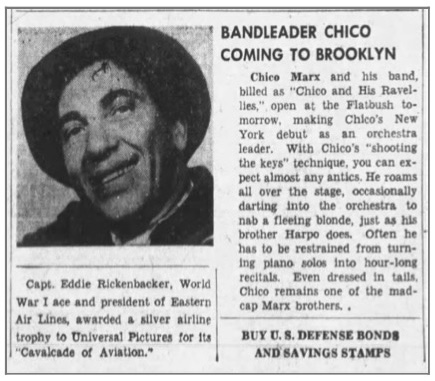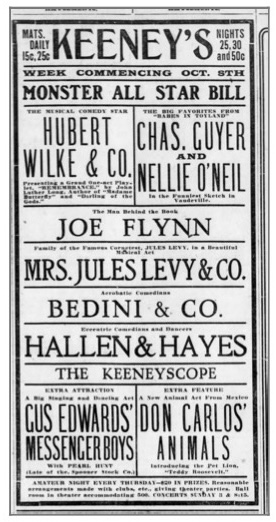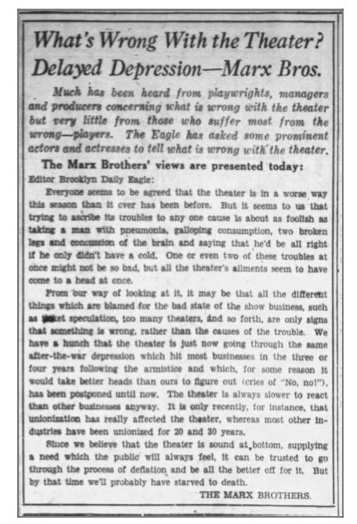
Hello, We Must Be Going — to Brooklyn
The Marx Brothers’ History in the Borough
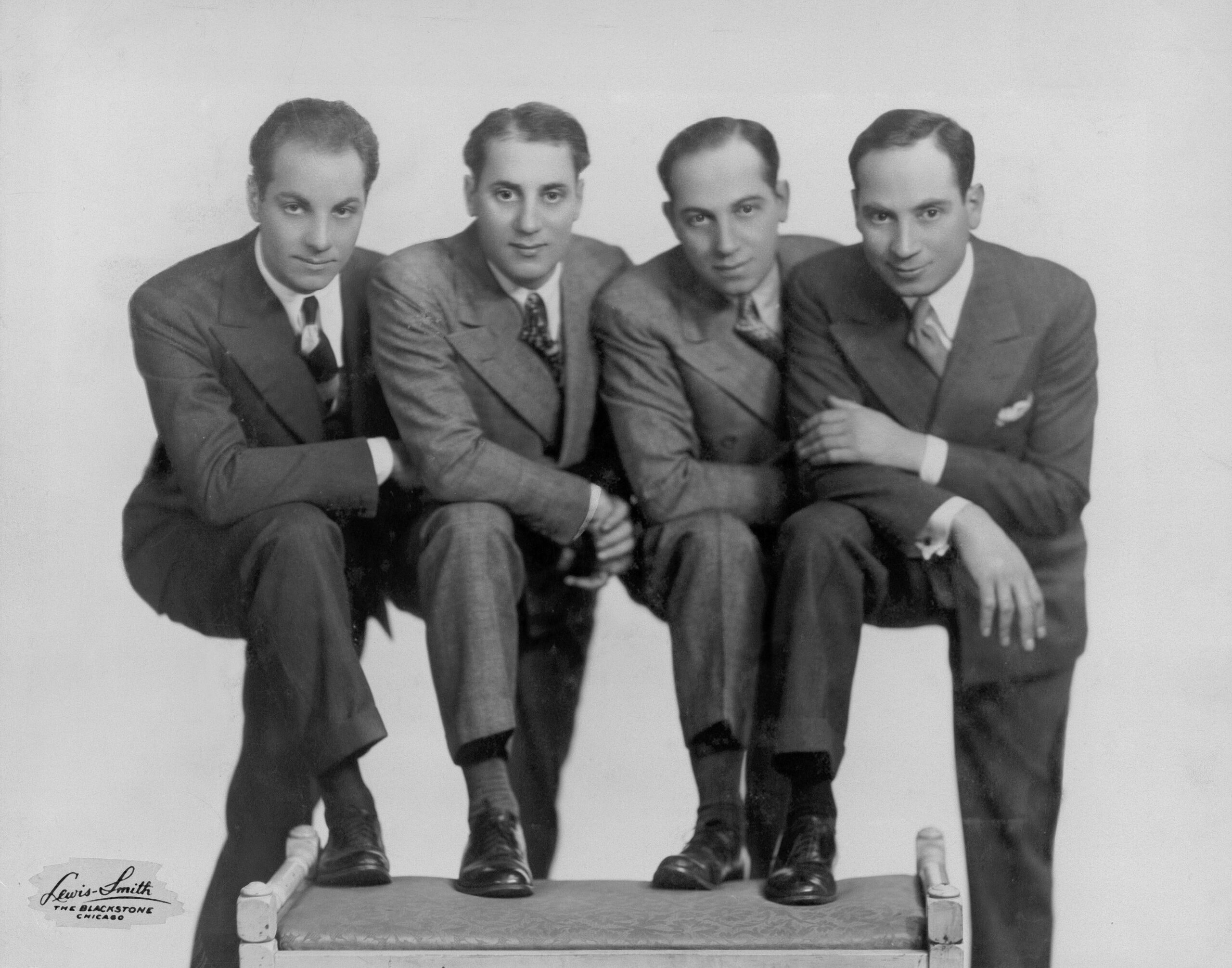
Photos courtesy of Marx Brothers. Inc.
Full slideshow below
During the early decades of the 20th century the fledgling recording, motion picture and radio broadcast industries were poised to rival and eventually surpass vaudeville, America’s primary form of popular entertainment. Many vaudeville attractions faded into oblivion. Several acts, however, endured through vaudeville’s waning years. Such was the case with The Marx Brothers. They persevered by honing their talents while ingeniously adjusting to the vicissitudes they encountered traipsing the boards for over twenty years.
The Marx Brothers’ apprenticeship flourished in their birthplace of Manhattan and also thrived in Brooklyn where they experienced many turning points, many of which would remain obscure or unknown without the scholarship of Marx Brothers historian Robert Bader. His book Four of the Three Musketeers: The Marx Brothers on Stage (Northwestern University Press; 2016/2022) is a chronicle of The Marx Brothers journey through their developing years, best described by Dick Cavett, whose 2022 PBS American Masters episode, Groucho and Cavett. Robert wrote and directed. “Robert Bader–focusing on the under-researched vaudeville days of the hilarious siblings–has gone where no man went before, discovering a treasure trove of Marxiana to delight the hearts and minds of those of us who can never get enough.” Robert has shared his knowledge and archival material for this article.
Going Legit
After I’ll Say She Is – with the brothers on the crest of a wave – Groucho insisted that their next Broadway show should not be a revue but should have an actual plot and story. George S. Kaufman, Morrie Ryskind and Irving Berlin wrote the Marxes a musical, The Cocoanuts, which opened on Broadway and ran for eight months, closing on August 7, 1926. This was the first time they worked with their Brooklyn-born foil, Margaret Dumont who would later appear in seven films with them.
In April 1927 the brothers performed The Cocoanuts at the Werba Theater at 409 Flatbush Extension, at Flatbush Avenue and Fulton Street. Their next Broadway show was Animal Crackers, which ran on Broadway for six months starting in October, 1928. in which Groucho introduced his theme song, “Hooray for Captain Spaulding” as well as “Hello, I Must Be Going.”
As they were about to film The Cocoanuts for Paramount at the Astoria, Queens studio they accepted a big money offer to return to vaudeville, which was luring big stars in a last gambit to compete with sound movies and legitimate theater. They agreed to play the Palace Theater in April, 1929 and perform highlights from Animal Crackers. One week after Animal Crackers closed on Broadway, they tested this truncated version on April 13, 1929 at the Madison Theater at 1410 Broadway in Brooklyn’s Bushwick section.
As the brothers were about to film Animal Crackers, they were once again enticed, now with the biggest salary ever paid in vaudeville, to perform a show consisting of highlights from their three recent shows. The brothers concocted The Schweinerei, which in German means all the scraps from the slaughterhouse floor from which hot dogs and sausage are made. This consisted of stitched together sequences from I’ll Say She Is, The Cocoanuts and Animal Crackers. In order to try out the show prior to playing The Palace, they did a split week during the first week of October, 1930 at The Keiths Theater in Flushing and then The RKO Albee Theater at 1 DeKalb Avenue. On October 4, the opening afternoon at the Albee, the brothers participated in an early radio broadcast from the theater on WBBC and WCGU.
The brothers concocted The Schweinerei, which in German means all the scraps from the slaughterhouse floor from which hot dogs and sausage are made. This consisted of stitched together sequences from I’ll Say She Is, The Cocoanuts and Animal Crackers. In order to try out the show prior to playing The Palace, they did a split week during the first week of October 1930 at The Keiths Theater in Flushing and then The RKO Albee Theater at 1 DeKalb Avenue. On Oct. 4, the opening afternoon at the Albee, the brothers participated in an early radio broadcast from the theater on WBBC and WCGU.
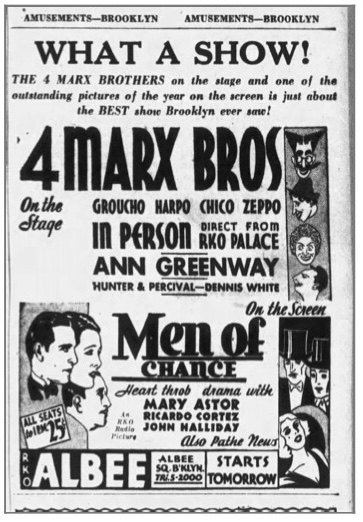
Zeppo Steps Away
In the fall of 1931The Marx Brothers took “Napolean’s Last Waterloo,” one of the biggest and most successful sequences in I’ll Say She Is, and expanded it into a full vaudeville show called Napolean’s Return. Groucho was Napolean and Lotta Miles, the Kelly- Springfield tire girl, was Josephine. The tour ended in January 1932 at the Albee. Zeppo never performed with The Marx Brothers on stage again. By this point, Zeppo had wanted to leave The Marx Brothers because he felt had been under-utilized. He was also on salary and not splitting the large paychecks with his brothers.
Napolean’s Return was the last stage performance of the Marx Brothers as a quartet, although Groucho. Harpo and Chico would later go on occasional tours as the Marx Brothers. Henceforward, they concentrated their energies on movies. On Dec. 10, 1941, Groucho returned to Brooklyn to appear at the Brooklyn Federation of Jewish Charities luncheon at The Hotel St. George at 111 Hicks Street.
Chico Strikes Up the Band
In January, 1942 Chico realized his vision of forming a big band when, with assistance from jazz band manager Ben Pollack, he launched The Chico Marx Orchestra. Chico fronted the band at the piano. The officially advertised world premiere engagement was from January 15 to 21, 1942 at the Flatbush Theater, although the band had already played in Elko, Nevada at The Commercial Hotel in December, 1941. Kitty Carlise, co-star of A Night at the Opera, was on the bill in Brooklyn. Later on, Mel Torme joined the band as singer and drummer.
A Brooklyn Daily Eagle clipping dated January 14, 1942, heralding Chico’s concert, said, “Chico Marx and his band, billed ‘Chico and his Ravellies,’ opens at the Flatbush tomorrow, marking Chico’s debut as an orchestra leader. With Chico ‘shooting the keys’ technique, you can expect almost any antics. He roams all over the stage, occasionally darting into the orchestra to nab a fleeing blonde, just as his brother Harpo does. Often, he has to be restrained from turning piano solos into hour-long recitals. Even dressed in tails, Chico remains one of madcap Marx Brothers.” Chico’s Flatbush engagement was the last instance of any of the Marx Brothers playing in Brooklyn.
As Brooklyn grew after the 1898 consolidation, it provided, in turn, a springboard for the Marx Brothers to hone their extraordinary talents, from their earliest vaudeville days to their 1923 breakthrough, which began at the Premier Theater and beyond. Here is where Groucho and Gummo developed their skills, where Harpo made his debut, Zeppo left the act and Chico triumphantly led his dream band. Owing to Robert Bader’s dedication we may fully grasp, to paraphrase “Hello, I Must Be Going,” “all their deeds so glowing” in Brooklyn.
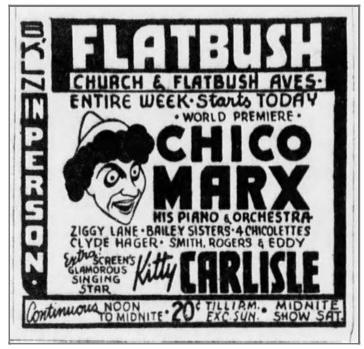
Postscript
While Animal Crackers was on Broadway, The Brooklyn Daily Eagle was running a recurring column posing the question, “What’s Wrong with the Theater?” Prominent stage personalities were asked to offer a reply. The January 13, 1929 edition featured The Marx Brothers’ droll response.
“Everyone seems to be agreed that the theater is in a worse way this season than ever before. But it seems to us that trying to ascribe its troubles to any one cause is as foolish as taking a man with pneumonia, galloping consumption, two broken legs and concussion of the brain and saying he’d be all right if he only didn’t have a cold. One or ever two of these troubles at once might not be so bad, but all the theater’s ailments seem to have come to a head at once.”
“From our way of looking at it, it may be that all the different things which are blamed for the bad state of the show business, such as ticket speculation, too many theaters, and so forth, are only signs that something is wrong, rather than the causes of the trouble. We have a hunch that the theater is just now going through the same after-the-war depression which hit most businesses in the three or four years following the armistice and which, for some reason it would take better heads than ours to figure out (cries of ‘No, no”), has been postponed until now. The theater is always slower to react than other businesses, anyway. It is only recently, for instance, that unionization has really affected the theater, whereas most other industries have been unionized for 20 and 30 years.”
“Since we believe that the theater is sound at bottom, supplying a need which the public will always feel, it can be trusted to go through the process of deflation and be all the better for it. But by that time we’ll probably have starved to death.”
- Marx Brothers in Brooklyn Timeline (courtesy of Robert Bader)
- Vaudeville Period
- Julius (Groucho) solo:
- June 18-23, 1906 – Gus Edwards Messenger Boys – Dreamland, Coney Island
- April 8-13, 1907 – Ned Wayburn’s Side Show – Hyde & Behman’s Theatre
- Julius (Groucho), Milton (Gummo):
- October 27, 1907 – Ned Wayburn’s Nightingales – Dewey Theatre (2 Sunday shows)
- Julius (Groucho), Milton (Gummo), Arthur (Harpo):
- June 1-6, 1907 – The Four Nightingales – Henderson’s Music Hall (This is the professional debut of Harpo Marx)
- February 26-28, 1912 – The Three Marx Brothers in Fun in Hi Skule – Loew’s Fulton
- February 29- March 2, 1912 – The Three Marx Brothers in Fun in Hi Skule – Loew’s Liberty
- March 7-9, 1912 – The Three Marx Brothers in Fun in Hi Skule – Loew’s Bijou
- Julius (Groucho), Milton (Gummo), Arthur (Harpo), Leonard (Chico):
- March 8 -13, 1915 – The Four Marx Brothers in Home Again – Bushwick Theatre
- March 29 – April 3, 1915 – The Four Marx Brothers in Home Again – Orpheum Theatre
- April 5 – 10, 1915 – The Four Marx Brothers in Home Again – Prospect Theatre
- March 5-11, 1917 – The Four Marx Brothers in Home Again – Orpheum Theatre
- March 19 – 24, 1917 – The Four Marx Brothers in Home Again – Bushwick Theatre
- Julius (Groucho), Arthur (Harpo), Leonard (Chico), Herbert (Zeppo):
- June 16 – 21, 1919 – The Four Marx Brothers in ‘N’ Everything – Henderson’s Music Hall
- July 7 – 12, 1919 – The Four Marx Brothers in ‘N’ Everything – Orpheum Theatre
- July 14 – 19, 1919 – The Four Marx Brothers in ‘N’ Everything – Bushwick Theatre
- January 26 – 28, 1920 – The Four Marx Brothers in ‘N’ Everything – Prospect Theatre
- August 30 – September 4, 1920 – The Four Marx Brothers in ‘N’ Everything – Brighton Coney Island Theatre
- September 5, 1920 – The Four Marx Brothers in Sunday Concert – Orpheum Theatre
- October 4 – 6, 1920 – The Four Marx Brothers in ‘N’ Everything – Keith’s Prospect Theatre
- November 15 – 20, 1920 – The Four Marx Brothers in ‘N’ Everything – Keith’s Bushwick Theatre
- November 22 – 27, 1920 – The Four Marx Brothers in ‘N’ Everything – Moss’ Flatbush Theatre
- May 2 – 7, 1921 – The Four Marx Brothers in On the Mezzanine Floor – Moss’ Flatbush Theatre
- May 9 – 14, 1921 – The Four Marx Brothers in On the Mezzanine Floor – Keith’s Bushwick Theatre
- June 6 -11, 1921 – The Four Marx Brothers in On the Mezzanine Floor – Keith’s Orpheum Theatre
- July 11 – 16, 1921 – The Four Marx Brothers in On the Mezzanine Floor – Brighton Coney Island Theatre
- September 29 – October 1, 1921 – The Four Marx Brothers in On the Mezzanine Floor – Keith’s Boro Park Theatre
- December 18 – 24, 1922 – The Four Marx Brothers in The 20th Century Revue – Shubert Crescent Theatre
- December 28 – 31, 1922 – The Four Marx Brothers in On the Mezzanine Floor – Keith’s Boro Park Theatre
- Julius (Groucho) solo:
- Broadway Period
- April 15 – 18, 1923 – The Four Marx Brothers in On the Mezzanine Floor – Premier Theatre
- April 21 – 26, 1924 – The Four Marx Brothers in I’ll Say She Is – Shubert Crescent Theatre
- April 18 – 23, 1927 – The Four Marx Brothers in The Cocoanuts – Werba’s Theatre
- April 13, 1929 – The Four Marx Brothers in Scenes from Animal Crackers – Madison Theatre
- October 4 – 9, 1930 – The Four Marx Brothers in The Schweinerei – RKO Albee Theatre
- January 9 – 14, 1932 – The Four Marx Brothers in Napoleon’s Return – RKO Albee Theatre (Zeppo’s final performances)
- Later Period
- December 10, 1941 – Brooklyn Federation of Jewish Charities luncheon – Hotel St. George (Groucho appeared with other stars)
- January 15 – 21, 1942 – The Chico Marx Orchestra – Flatbush Theatre
- Vaudeville Period
Full slideshow below
(Click to enlarge)
Leave a Comment
Related Articles


Milestones: May 8, 2024

May 7: ON THIS DAY IN HISTORY

Milestones: May 7, 2024
Leave a Comment

Brooklyn Boro
View MoreNew York City’s most populous borough, Brooklyn, is home to nearly 2.6 million residents. If Brooklyn were an independent city it would be the fourth largest city in the United States. While Brooklyn has become the epitome of ‘cool and hip’ in recent years, for those that were born here, raised families here and improved communities over the years, Brooklyn has never been ‘uncool’.
The Brooklyn Daily Eagle and brooklyneagle.com cover Brooklyn 24/7 online and five days a week in print with the motto, “All Brooklyn All the Time.” With a history dating back to 1841, the Eagle is New York City’s only daily devoted exclusively to Brooklyn.
© 2024 Everything Brooklyn Media
https://brooklyneagle.com/articles/2023/10/14/hello-we-must-be-going-to-brooklyn/


